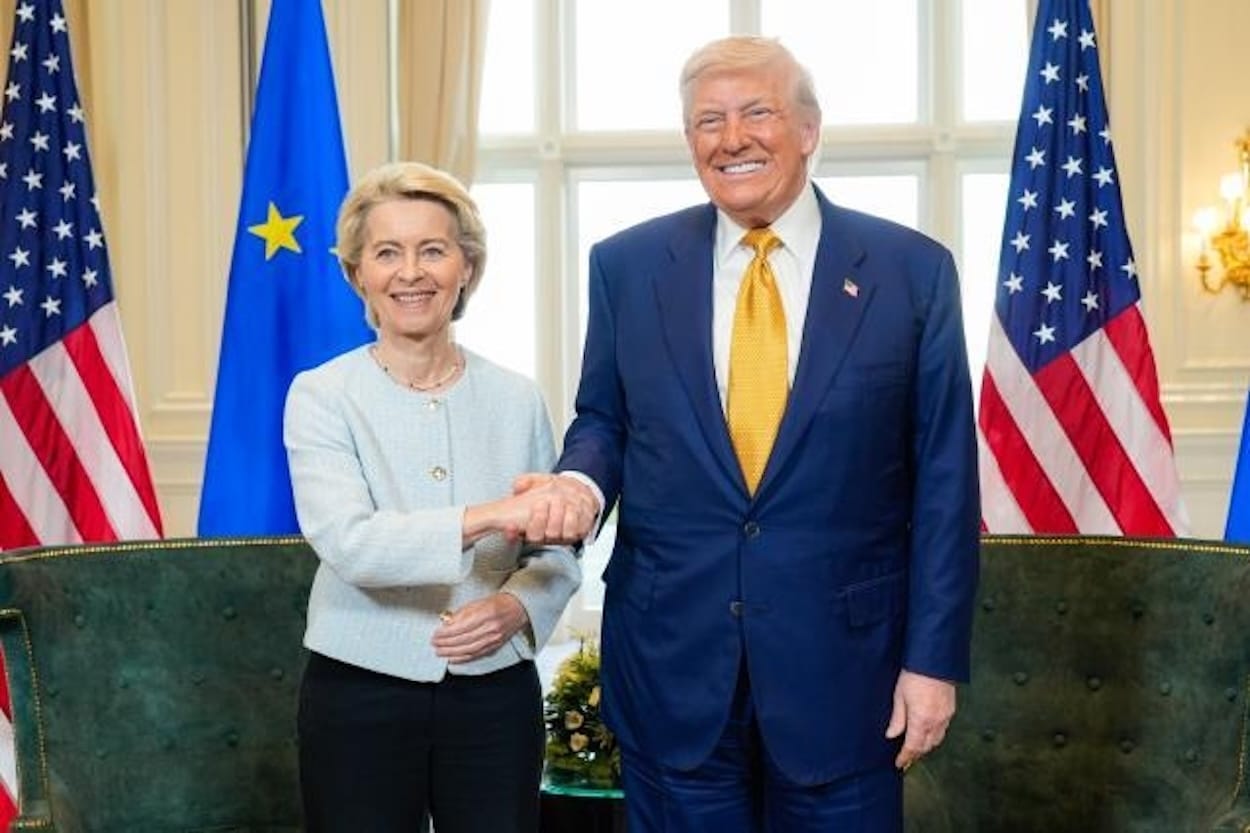Many consider it an unprecedented concession to U.S. pressure: the European Union has agreed with the Trump administration to raise tariffs from 5% to 15% on most European products exported to the United States. The deal, reached “at the last minute” to avoid implementing a 30% tariff penalty starting August 1, has been portrayed as a diplomatic success by both sides. However, it carries troubling economic and strategic implications for the European bloc.
A triple increase… disguised as a victory
According to the official statement from Commission President Ursula von der Leyen, the pact provides “certainty in uncertain times” and safeguards transatlantic trade, valued at $1.7 trillion annually. Yet, behind this narrative of stability lies a harsher reality: Europe has agreed to triple its average tariff rate imposed by the U.S., rising from the current 4.8% to a fixed 15% for “almost all key sectors,” including automobiles, semiconductors, machinery, chemicals, and pharmaceuticals.
The new framework is not merely about harmonization; it establishes a higher trade barrier that will increase costs for European products in the U.S. market, directly impacting the competitiveness of strategic sectors and squeezing exporters’ margins.
A $1.35 trillion check to seal the deal
Less publicized is the direct cost Europe will shoulder to avoid trade penalties:
- $750 billion in U.S. energy purchases (liquefied natural gas, oil, nuclear fuel).
- An additional $600 billion in direct investment and military imports from the U.S.
These figures mark a geopolitical shift that began after Russia’s invasion of Ukraine but is now becoming institutionalized: Europe is replacing Russian energy dependency with energy—and technological—dependence on the United States.
What does Europe give up?
The agreement not only makes access to the U.S. market more expensive—its biggest external client—but also introduces a structural asymmetry in the economic relationship. While Washington continues its protectionist industrial agenda, Brussels cedes a significant portion of its economic sovereignty to avoid a trade conflict.
From an economic perspective, the risks are numerous:
- Loss of competitiveness for industries that now must absorb an additional 15% in costs to export.
- Indirect inflationary impact on European products with transatlantic supply chains.
- Distorting effects on European energy policy, by imposing external purchase commitments over investments in renewables or domestic sources.
- Technological dependency in areas like artificial intelligence, where NVIDIA and AMD chips are now standard.
As the chief economist of the Bruegel think tank recently warned, “the problem isn’t the 15%; it’s that this is presented as a success while moving away from the strategic autonomy Europe claims to pursue.”
An election-year Trump victory?
From the American perspective, the deal is a political, industrial, and diplomatic win. Trump has touted it as a display of strong negotiation: he issued an ultimatum, froze the 30% threat, and in return, secured more purchases of gas, oil, weapons, and chips—along with tariffs that favor domestic production.
The fact that von der Leyen explicitly thanked the U.S. president for his “commitment and leadership” has drawn criticism even inside the European Parliament, where some MEPs describe the pact as “surrender without a shot fired.”
What’s next?
The agreement includes some positive elements: a list of strategic products with zero tariffs (aircraft, critical raw materials, certain chemicals and pharmaceuticals), strengthened energy cooperation, and a commitment to negotiations aimed at reducing non-tariff barriers further. Yet, these benefits pale compared to the economic sacrifice — roughly $1.35 trillion — that Europe has accepted to avoid a crisis.
The big question is whether this approach will be repeated with other strategic partners or serve as a lesson to accelerate a true European industrial policy. Because if the EU must pay $1.35 trillion just to maintain access to the U.S. market, how can it compete with Asia or Latin America without its own protective mechanisms?
Summary table of the EU-U.S. agreement
| Aspect | Before | Now | What Changes |
|---|---|---|---|
| U.S. tariff on EU products | Approx. 5% (~4.8%) | Fixed 15% from August 1 for most key sectors | Tripling of the average; avoiding 30% but cementing 15% |
| EU concessions | — | $750 billion in energy purchases + $600 billion in investment | Europe pays to close the deal and avoid retaliation |
The new trade agreement between the EU and the U.S. reflects the current limits of European power. Without a solid industrial base or autonomous energy strategy, Brussels has preferred to pay and concede rather than confront. But the cost extends beyond dollars—impacting influence, competitiveness, and strategic autonomy.

